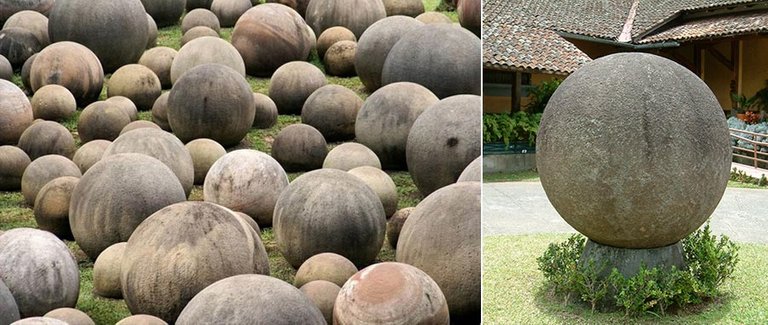
Round Rock (or stone balls) of Costa Rica is a group of rounded stones that add up to more than three hundred in Costa Rica, found in the Diquis delta, Isla del Caño. Locals call it the Las Bolas, and also called the Diquis Spheres. These objects are the result of cultural works Isthmo-Colombia.
Description
The balls diameter of only a few centimeters to more than 2 metres (6.6 ft), and weighing around 15 tons. Mostly made of gabbro, fibrous quartz rocks such as basalt. There are dozens of balls made from limestone, and dozens more made of sandstone.
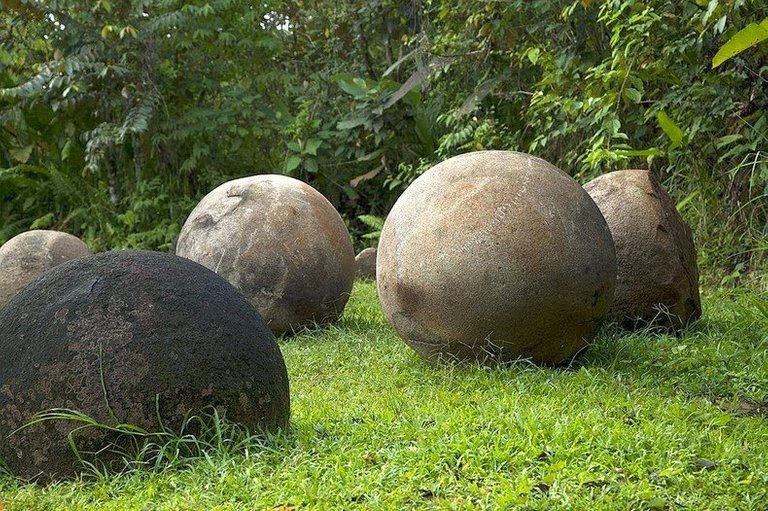
Where Is The Stone?
The stone was originally found in Térraba River delta, also known as Sierpe, Diquís, and common River, near the city of Sur and Norte palmaris palmaris. The ball known from as far north as far as the South of the Valley and the Estrella River Coto Colorado. The spiral stones have been found near the Golfito and on Isla del Cano. Discovered in 1940 's.
They were transported, mainly by train, all over Costa Rica. They are now found throughout kostarika. There are two balls on display to the public in the U.S. one of them is in the museum of the National Geographic Society in Washington d.c. and in a courtyard near the Peabody Museum of archaeology and ethnography, at Harvard University in Cambridge, Massachusetts.
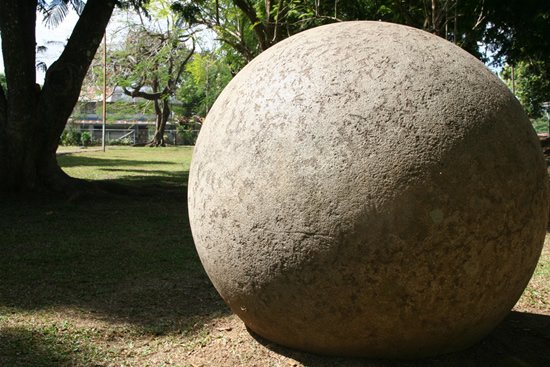
How Big Is The Spiral Stone?
Ball sizes range from just a few centimeters to over two meters in diameter. It is estimated that the largest weighing more than 16 tons (approx. 15,000 kg).
After the Arrival of European History
A round stone in front of the Embassy of Costa Rica in Washington, D.C. as their national identity.

The stones found in the 1930-40s when the United Fruit Company was being membabat the forest for plantations of bananas. The workers pushed the stones with bulldozers and other heavy equipment, thereby damaging some of them. In addition,inspired by the story of the existence of the gold is hidden, the workers began drilling into rocks and blow it up with a few stems of dynamite. Some of the stones were destroyed until the authorities intervened. Some stones have been destroyed have been reassembled and are now on display at the National Museum of Costa Rica in San José.
The first scientific research about the stones was performed shortly after its discovery by Doris Stone, the daughter of the head of the United Fruit Co. The results were published in 1943 in American Antiquity, to attract the attention of Samuel Kirkland Lothrop [4] of the Peabody Museum at Harvard University. [5] in 1948, he and his wife tried to unearth archaeological regions of other northern Costa Rica.
The Government at that time to dissolve his professional troops, resulting in restlessness and threatens the security of the population group of Lothrop. In San José he met Doris Stone, who led the group toward the Diquís delta region in the Northwest ("Valle de Diquís" refers to a valley in the lower reaches of the Río Grande de Térraba, including ghetto Osa Canton in Puerto Cortés, Palmar Norte, and Sierpe) and shows important excavation sites and share personal contact respectively. Lothrop's discovery was published in the Archaeology of the Diquís Delta, Costa Rica 1963.
Year 2010, researchers from the University of Kansas, John Hoops, visiting the site ofthe round stone to evaluate their worthiness to be protected as a UNESCO World Heritage site.
Made of Whether The Spiral Stone?
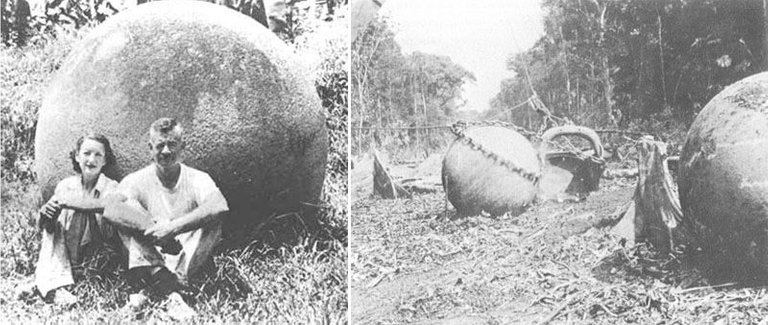
Almost all the balls made of granodiorite, a hard, fiery rock outcrops in the nearby foothills of the Talamanca range. There are some examples made of Coquina, a hard material that is similar to the limestone formed from clams and sand deposits. The possibility brought inland from the mouth of the Térraba-Sierpe delta.
How Are They Made?
The ball is most likely created through a combination of controlled fracture, Peck, and grinding. Granodiorite rock from which made has proven to exfoliate lapisannya when subjected to rapid temperature changes. The ball could have been mengasarinya out through the application of heat (hot coals) and cold (cold water).
When the stone is at hand in the form of balls, stone reduced by banging with rocksmade of hard materials. After that a high luster polished. This process is similar to the one used to create the polished stone axes, metates, and elaborately carved sculptures of stone, it was achieved without the help of metal tools, laser beams, or alien life forms.
Who makes The Spiral Stone?
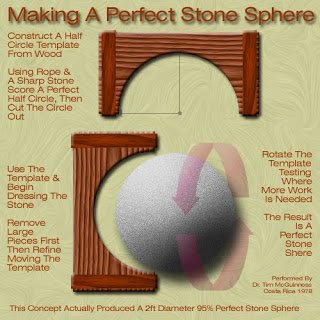
The ball was most likely made by ancestors of the indigenous population living in the area at the time of the conquest of Spain. These people speak the language of the Chibcha.
How Old Is The Rock?
The spiral stone reportedly has been found in a cemetery with a gold ornament style that originated after about the year 1000. The Spiral stones have also been found in the layer containing the remains of Buenos Aires polychrome, a type of ceramic Chiriqui Period made beginning around the year 800.
This type of pottery is reported to have been found in association with the colonial period iron tools, shows it was produced until the 16th century. So, the ball could have been done at any time during the period from the year 1800. The first balls mademay last for generations, during which they could have been moved and modified.

Myth
Some myths circulating around the stone, for example, it is said that they came from Atlantis, or they are created naturally by nature. Local legend States that the natives there have a drug that is able to soften rocks.
Research led by Joseph Davidovits of Geopolymer Institute in Northern France supports this hypothesis, but not supported by geological or archaeological. (no one was able to show that the gabbro, materials that are widely used to create the rock, can be lenient.)

The roundness of the rocks was declared perfect, or very perfect, though some approached stone is known to vary between 5 sentimetres (2.0 in) in diameter. Some of the stones have also been damaged and eroded over the years, making it impossibleto know with certainty how the original form.
A review on how the measurement is done by Lothrop precision statement revealing that form occurs due to a misinterpretation of the methods used in the measurements. Although Lothrop publishing table diameter balls with numbers to three decimal places, the numbers are actually an average size taken with Ribbons that he/she not to like it.
Referance
Source:
travel.tribunnews.com
contohartikel-ku.blogspot.co.id

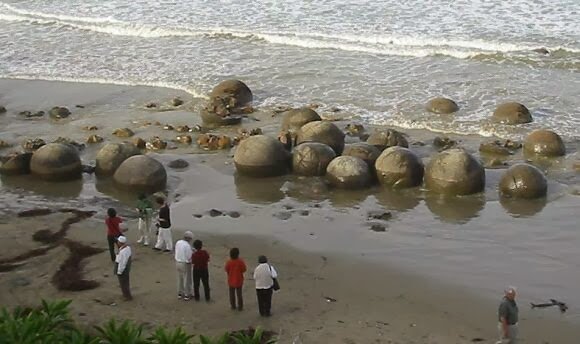
You received a 10.0% upvote since you are not yet a member of geopolis and wrote in the category of "archeology".
To read more about us and what we do, click here.
https://steemit.com/geopolis/@geopolis/geopolis-the-community-for-global-sciences-update-4